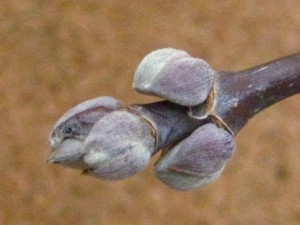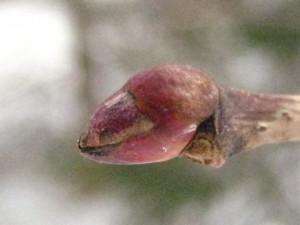Buds, to use strict botanic terminology, are those little bumps on the ends of twigs that no one ever notices. Until one fine day, when the little bumps burst open and reveal the leaves and blossoms of spring that we’ve all been longing for. As miraculous as a chick hatching out of its shell.
It’s been a long hard winter, and everyone’s delighted to see the new green leaves bursting forth on the branches—the leaves of this spring. But when did the buds start incubating those baby leaves? Last spring, a full year ago. At the base of each and every leaf on each and every tree, a tiny speck formed. Those specks, beginning their growth last year, eventually became the leaves of today.
Buds, like eggshells, are protective casings for the embryonic life developing inside. Most buds have two or more overlapping scales, which are actually modified leaves. Often, the bud scales have a waxy coating, shiny as a new car, which helps to keep moisture inside the bud so the young leaves won’t get dehydrated. The bud scales are hard like an eggshell, to protect the fragile new life inside.
Buds come in a wild array of colors and shapes and sizes. In winter, when the leaves are long gone, it can be tough to identify trees. You can use the bark for identification, sure, but on most trees bark just looks like, well, bark—brown, craggy and nondescript, so it’s easy to end up (forgive me) barking up the wrong tree. But buds are distinctive—you can’t miss, for example, the pointed spearheads, an inch long, that are the buds of beech trees. Box elder buds are short, squat and whitish, almost woolly.  Oak buds cluster at the tips of twigs. The terminal (end-of-twig) buds of flowering dogwoods look just like little onions. And the buds of the sugar maple tree are the exact color of maple syrup.
Oak buds cluster at the tips of twigs. The terminal (end-of-twig) buds of flowering dogwoods look just like little onions. And the buds of the sugar maple tree are the exact color of maple syrup.
In summer, buds hide at the base of the leaves. Month by month, the buds grow imperceptibly bigger. Then winter arrives, the leaves fall off, and there on the naked branch the buds wait, the coming leaves already formed, curled snugly inside the weatherproof layer of outer bud scales. Scratch one of these winter buds with a fingernail, in the deepest depths of winter, and you’ll see a hint of green, a preview of the summer that lies within.
Finally, finally, spring gets around to arriving. Longer days, with extra sunlight and warmer temperatures, signal the trees to get busy. Sap flows, roots lengthen, buds pop open. And the trees, blossoming and leafing with all their might, are actually doing double duty. Planning ahead, so to speak. At the base of each and every brand new leaf on each and every tree, a speck is forming. The leaves of next spring, still infinitesimally tiny. But they’re waiting, biding their time until they unfurl to greet us a year from now. A guarantee of springs yet to come.





Can’t wait for our magnolia to start blooming!
A few days ago, someone asked me when the buds
would form. I pronounced, “They’re already there!”
Actually I was a bit unsure, so I am thrilled to be
vindicated. Thank you for this important, and oft
overlooked, information.
When we are in the worst of winter, or whenever I am dreary of it, I look for buds for reassurance!